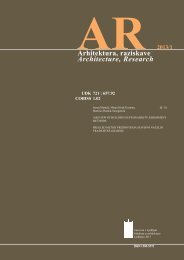Revija 2005/1 v PDF - Fakulteta za arhitekturo - Univerza v Ljubljani
Revija 2005/1 v PDF - Fakulteta za arhitekturo - Univerza v Ljubljani
Revija 2005/1 v PDF - Fakulteta za arhitekturo - Univerza v Ljubljani
You also want an ePaper? Increase the reach of your titles
YUMPU automatically turns print PDFs into web optimized ePapers that Google loves.
AR 2oo5 / 1Martina Zbašnik-Senegaènik, Janez KresalPREDELNE STENEPARTITION WALLSraziskava, researchpovzetekPredelne stene v zgradbi loèujejo prostore, njihove ostalefunkcije pa so še nosilnost, zvoèna, poarna in toplotna <strong>za</strong>šèita,tesnost, hkrati pa nudijo tudi psihološko ugodje. V zgodovini sobile najveè v uporabi stene iz zidakov in blokov, ki so pove<strong>za</strong>nimed seboj z malto. Prvo monolitno konstrukcijo predstavljabutana stena iz ilovice, pojav betona pa je število monolitnih stenbistveno razširil. Sredi 20. stol. je tenja po hitremu prilagajanjutlorisne <strong>za</strong>snove zgradbe trenutnim potrebam in razvoj serijskeproizvodnje pripeljal do izdelave tipskih predelnih sten zenotnimi moduli, ki so omogoèali variacije razliènih postavitev.Stene so postale lahke, enostavne <strong>za</strong> vgradnjo, pa tudi hitrodemontao. V <strong>za</strong>dnjih desetletjih so se predvsem sistemineprosojnih predelnih sten racionalizirali do te mere, da so sipostali zelo podobni. Izbira razliènih oblog, ki je bila donedavnega na voljo, se je skrèila na uporabo mavèno-kartonskihplošè. Unikatno oblikovanje in izdelava sta seveda iz te trditveizvzeti. Veèji spekter izbire nudijo sistemi prosojnih predelnihsten s pestro izbiro stekel in površinskih obdelav.V raziskovalni nalogi so podrobneje obdelane funkcijepredelnih sten, njihova zvoèna in protipoarna <strong>za</strong>šèita. Predelnestene so sistemizirane v pregledne sheme. Posamezni termini soobdelani v obliki glosarja.doseeni cilji, namen in rezultatiV raziskovalni nalogi so obravnavane stenske konstrukcijeznotraj zgradbe, katerih primarna funkcija je loèevanje prostorov,druge funkcije pa so še doprinos k statièni stabilnosti objekta,zvoèna, toplotna in poarna <strong>za</strong>šèita, <strong>za</strong>gotavljanje tesnosti medposameznimi enotami, izravnavanje vlage v prostoru inustvarjanje psihološkega udobja v prostoru.Predelne stene so uvodoma sistematsko razdeljene porazliènih kriterijih (po konstrukciji, nosilnosti, funkciji inpremiènosti). Vsak pojem je podrobneje obdelan v <strong>za</strong>dnjempoglavju Glosar. V srednjem delu naloge sta podrobnejepredstavljeni podroèji zvoène in poarne <strong>za</strong>šèite predelnih sten.Namen naloge je sistemizirati predelne stene po razliènihkriterijih in poiskati <strong>za</strong>nje relevantne premere iz prakse.Rezultat raziskave bo sluil kot pomono gradivo pripredmetu Tehnologija gradnje in gradivo v arhitekturi.problematika v arhitekturi, umestitevobravnavane teme v te tokove in njen pomenRazvoj tehnologije gradnje je danes tudi pri predelnih stenahzelo hiter. Pojavljajo se številni novi sistemi, ki nadomešèajoklasiène toge predelne stene. Te niso nudile monosti poprilagajanju trenutnim potrebam, kar omogoèajo današnje lahkein še zlasti premiène predelne stene. Današnje trišèe ima navoljo številne sisteme. V okviru raziskovalne naloge smoovrednotili njihove funkcije, poiskali relevantne primere <strong>za</strong>nje inopredelili glavne pojme, ki so potrebni <strong>za</strong> razumevanje inposledièno izbiro pravega sistema v projektantski praksi..kljuène besedepredelne stene, funkcije predelnih sten, zvoèna <strong>za</strong>šèita predelnihsten, poarna <strong>za</strong>šèita predelnih stensummaryPartition walls in buildings separate spaces; their otherfunctions are load-bearing capacity, noise-, fire- and heatinsulation, water-tightness, but they simultaneously have to offerpsychological comfort. Historically speaking the most often usedwalls were made of bricks or blocks, bonded together withmortar. The first monolithic structure was the compacted claywall; with the introduction of cement the use of monolithic wallssignificantly proliferated. The tendency for quick adaptation ofbuilding layouts to pending needs and the development of serialproduction in the mid 20th century instigated the production oftypified partition walls with uniform modules, which enabledvariations in placement. Walls became light, simple for assembly,but also de-assembly. In the last decades mainly systems of nontranslucentpartition walls were rationalised to such an extentthat they became very similar. The choice of various coatings,available until recently, has become limited to the use of plastercardboardplates. Unique design and production are of courseexempt from this statement. A larger choice spectre is offered fortranslucent partition walls, where there is a varied offer of glassand surface treatments.Functions, noise muffling capacity and fire safety of partitionwalls were researched in more detail. Partition walls aresystemised into easily legible charts. A glossary with describedterms was added.intentions, goals and resultsThe research dealt with wall structures inside buildingswhose primary function is separation of spaces, while their otherfunctions contribute to the building's stability, noise, heat and fireinsulation, ensuring water-tightness between particular units,equalising humidity in the space and providing psychologicalcomfort.Partition walls were first systematically divided according tovarious criteria (structure, load-bearing capacity, function andmobility). All the terms were dealt with in detail in the lastchapter, the Glossary. The central part of the research gives adetailed account of noise and fire insulation of partition walls.The intent of the research was to systemise partition wallsaccording to various criteria and find relevant illustrativeexamples from practise.The result of the research will be used as additional materialfor the course Building technology and materials in architecture.architectural issues, positioning the topicin ongoing debate and its’ significanceToday building technology is developing very fast, even ofpartition walls. Numerous new systems are emerging, whichsubstitute classical rigid partition walls. The latter didn't offerpossibilities for adapting to present needs, which arenevertheless catered to by modern light and especially mobilepartition walls. The market today offers numerous systems.Within the research framework we evaluated their functions,found relevant illustrative examples and defined the main termsthat are needed for understanding and consequential choice ofthe suitable system in architectural practise.key wordspartition walls, functions of partition walls, sound insulation,sound insulation of partition walls, fire protection of partitionwalls79
















